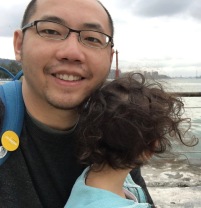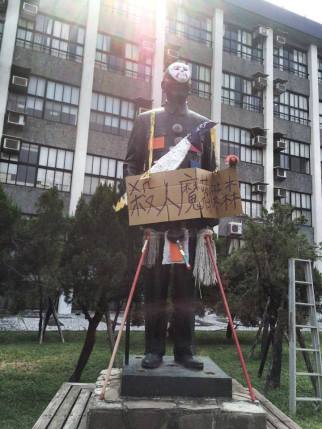
Shen-yi Liao is an Assistant Professor of Philosophy at University of Puget Sound. He was a Marie Curie Fellow at University of Leeds, an Assistant Professor at Nanyang Technological University, a Visiting Assistant Professor at Kansas State University, a PhD student at University of Michigan, and a BA student at Rutgers, the State University of New Jersey. He is Taiwanese. He has published on the cognitive science of imagination, experimental methods in philosophy, and relationships between morality and aesthetics. His other research and teaching interests include philosophy of race and classical Chinese philosophy. His website is liao.shen-yi.org.
Oppressive Statues
Shen-yi Liao

In this picture, a Chiang Kai-shek statue is dressed up as Jason Voorhees, the serial killer from Friday the 13th movies: like Jason, it is wearing a mask and wielding a (handmade) machete. Just in case you missed the reference, the installation artists have helpfully hung a big sign over the statue that said “serial killer Chiang Jason”.
Chiang Kai-shek (蔣中正) was a murderous dictator. He ordered the February 28 Massacre, in which 10000-50000 Taiwanese people were killed by the colonial Republic of China forces. In the White Terror period that followed, from 1949 to 1987, many more Taiwanese people were imprisoned, executed, or disappeared. Yet today, statues of Chiang Kai-shek remain pervasive in Taiwan. You can find them in parks, in schools, and in major tourist sites like the memorial hall that bears his name.
In recent years, there is a nascent movement to turn Chiang Kai-shek statues into installation artworks around February 28th. (The photo above, and many others, can be found at this Facebook group.) Some installations are serious, and others are whimsical. Some involve splashes of paint, some involves papers of victims’ names, and others involve even more elaborate props. By some measures, the movement is successful. Some municipalities have chosen to remove Chiang Kai-shek statues. And there is now increased police protection of prominent statues around historically significant dates.
There continues to be controversy about what should be done with Chiang Kai-shek statues in Taiwan. In this respect, they are not unique. Similar controversies remain regarding the John C. Calhoun monument in Charleston and Cecil Rhodes statues in South Africa and Oxford. In each case, the controversy has centered on the question of whether the statues should be removed or preserved. In Taiwan, the removalists argue that the statues must go because they are symbols of authoritarianism and the preservationists argue that the statues must stay because they are markers of history. Analogous arguments have been made with the other statues too.
I think the wrong question is being asked. The options of removal or preservation are neither mutually exclusive nor exhaustive. To really understand what we might do with these statues, we need to ask more fundamental questions about what they are and what they do. My answer, to preview, is that these statues are oppressive things that structure our thoughts and behaviors, and in doing so, they set forth norms about which responses to the statues are permissible and which responses are not.
* * *
To think about what oppressive things are, we need to take a small detour. Around this time last year, I traveled to Miami to give a talk and stayed at a little bungalow that I rented via Airbnb. After a long flight, I wanted to take a warm shower before exploring the town for the evening. So I turned the shower on, but it was cold. I turned the left-hand knob all the way up and the right-hand knob all the way down, but it was still cold. I never got my warm shower that evening. The next day, only by accident did I figure out why: against the norm, whoever built this little bungalow had connected the hot water to the right-hand knob and the cold water to the left-hand knob.
This is a mundane example, but it also illustrates the ways in which material things in our lived environments can structure our patterns of thoughts and behaviors. In this case, the shower knobs structured my thoughts and behaviors in (at least) three ways. First, it served as a prompt for associative thinking. Unconsciously and automatically, I associated the left-hand knob with hot water and the right-hand knob with cold water. Second, it served as a guide for elaborative and imaginative thinking. When the shower came out cold, I thought to change that by turning the left-hand knob up even more. In fact, I did not even imagine the possibility that the left-hand knob could be connected to cold water. Third, it served as a motivator for behavior. I took the actions that naturally followed my automatic and deliberate thoughts.
There is an especially interesting class of material things that structure our patterns of thoughts and behaviors in congruence with systems of oppression. Call them oppressive things. Chiang Kai-shek statues are good examples.
Signs of their oppressive nature can be found in the guidelines for their construction. Like other such statues, they are not intended to be neutral historical representations of a person. Instead, as the guideline states, they are sculpted to show Chiang Kai-shek’s “spirit of compassion, wisdom, courage, determination, and optimism”. They are also more than statues of a person. Given the social and historical context in which the “mainland Chinese” (waishengren) exerted violent domination over the “Taiwanese” (benshengren), these statues also function as physical anchors of that oppression.
These oppressive things demand people in their presence to associate Chiang Kai-shek and his oppression with compassion and courage. In turn, the statues also function as guides for mandated re-imaginings of Chiang Kai-shek and of Taiwanese history. And, of course, these ways of thinking are intended to encourage behaviors of honor and respect. The official authorization of these statues’ physical presence adds another dimension to their impact: they do not merely structure particular patterns of thoughts and behaviors, they are meant to normalize them.
* * *
We can also think about what oppressive things do by exploring an analogy between language and art. A central insight of speech act theory is that words do not merely represent, they also do things. As mentioned, oppressive things such as Chiang Kai-shek statues also do more than just represent. In particular, qua public statues, they not only encourage some behaviors like honor and respect, they also prohibit other behaviors.
In a series of papers, Mary Kate McGowan has honed in on a kind of speech act called the exercitive, which enacts permissibility facts. Consider one of her examples. A restaurant owner in the segregated South puts up a sign in his restaurant that says “Whites Only”. In doing so, he does not merely represent the racial composition of his clientele, he also makes it the case that non-whites are not permitted to enter his restaurant. In this example, the sign has this force partly because the permissibility facts it enacts are in congruence with racial oppression in the US.
Oppressive things also enact permissibility facts. Even if you do not judge Chiang Kai-shek to be worthy of honor and respect, in the statues’ presence you must behave as if you do. You are not permitted to act disrespectfully toward the statue. For example, you cannot place a mask over its face, put a machete in its hand, and label it “serial killer Chiang Jason”. Indeed, as mentioned, Chiang Kai-shek statues demand so much honor and respect that police protections are necessary to preempt such behaviors.
People do things with words, even if the words are not their own. By letting the “Whites Only” sign stand, the patrons of the racist restaurant are consenting to, and perhaps socially sanctioning, the permissibility facts that the “Whites Only” sign enacts. Similarly, by letting oppressive things stand, we also seem to be consenting to, and perhaps socially sanctioning, the permissibility facts that they enact.
* * *
Despite some differences, there are obvious similarities between the oppressive statues and institutions named after dead racists. In writing about the latter, Regina Rini has argued that to answer the question of should we rename institutions that honor dead racists, we need not ask for comprehensive judgments of the dead racists’ moral character; rather, we need to only ask ourselves whether the continuing uses of the dead racists’ names reflect our values.
I think Rini’s insight applies to oppressive things too. We need not be asked to make comprehensive judgments about the moral characters of the people represented. Instead, we need to only ask ourselves whether we want to continue to encourage particular patterns of thoughts and behaviors, and to continue to enact particular permissibility facts.
Suppose we decide that we do not, removal is not the only option. There are other ways of changing the thoughts and behaviors that Chiang Kai-shek statues encourage and the permissibility facts that they enact. For example, we as a democracy might open them up as materials for installation artworks that critically examine Chiang Kai-shek or his oppression. In doing so, the statues can remain markers of history—not only of the past, but also of our present.
Thanks to Meena for the opportunity. And thanks to Sara Protasi, Regina Rini, and Bryce Huebner for feedback!